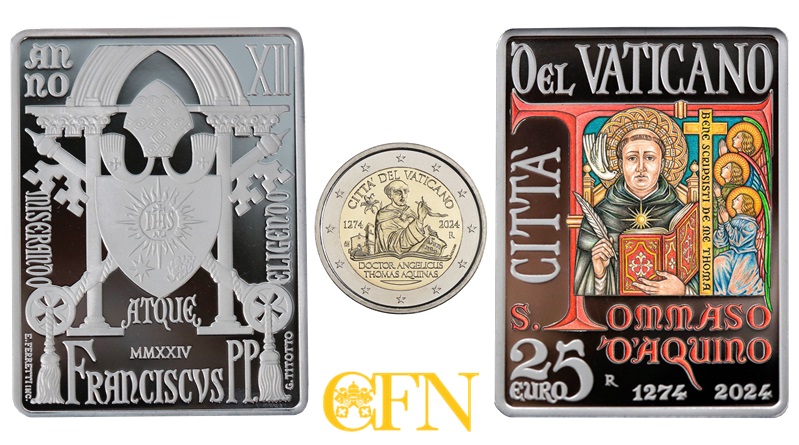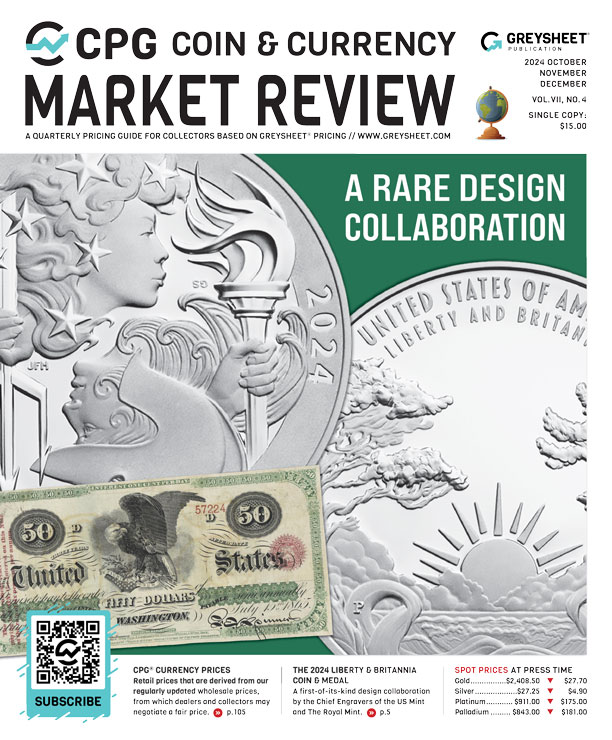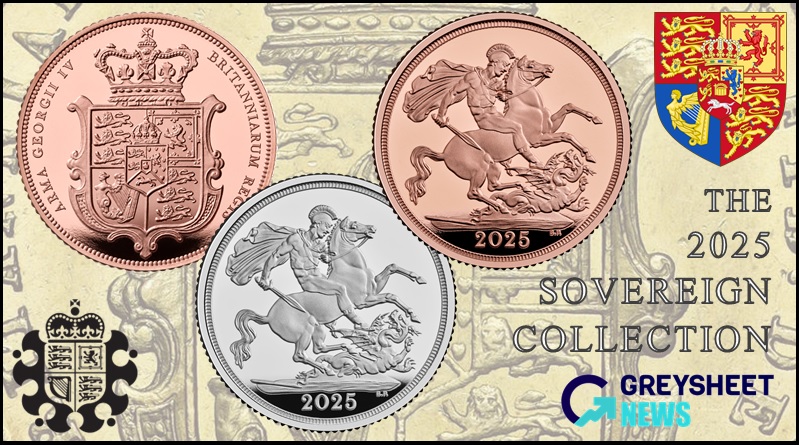Vatican City: New Ingot-shaped Silver Proof Coins Mark 750th Anniversary Of The Death Of Saint Thomas Aquinas
The Vatican Mint and Treasury of the Holy See have launched two new collector coins for a very special observance.
This year marks the 750th anniversary of the death of Saint Thomas Aquinas (ca. 1225 - 1274) considered as one of the greatest of the Scholastic philosophers. St. Thomas’ teachings and extensive writings explored the relationship between the mind of man and the mind of God. His synthesis of knowledge relating to this joining of intellect and religious belief, entitled The Summa Theologica (1267-1273) earned him a lasting reputation among both scholars and religious alike.
Born into nobility between the years 1224/25, Roccasecca, near Aquino, in the Kingdom of Sicily, his family were distinguished in the service of Emperor Frederick II during the civil unrest in southern Italy between papal and imperial forces. His future may have been remarkably foretold by a holy hermit who shared a prediction with his mother, before his birth that her son would enter the Order of Friars Preachers, become a great learned man and achieve unequalled sanctity. This prophecy was perhaps fulfilled by following the tradition of the period, the young Thomas was sent to the Abbey of Monte Cassino to train among Benedictine monks when he was just 5 years old, remaining there until the age of 13. From 1245 to 1252, Saint Thomas Aquinas continued his studies with the Dominicans in Naples, Paris and Cologne, Germany where he was ordained in 1250. Thomas Aquinas subsequently earned his doctorate in theology and consistent with the holy hermit's prediction, he proved an exemplary scholar. After reading Thomas's thesis and thinking it brilliant, his professor, Saint Albert the Great, proclaimed that doctrine will one day ‘resound throughout the world!’
After completing his education, Saint Thomas Aquinas devoted himself to a life of traveling, writing, teaching, public speaking and preaching. Religious institutions and universities alike yearned to benefit from the wisdom of the man many were calling "The Christian Apostle." However, at the forefront of medieval thought was a struggle to reconcile the relationship between theology or, faith and philosophy or, reason. Scholars were at odds as to how to unite the knowledge they obtained through revelation with the information they observed naturally using their mind and their senses. In answer to these existential questions, Saint Thomas Aquinas believed that the existence of God could be proven in five ways, mainly by,
1 - Observing movement in the world as proof of God, the "Immovable Mover"
2 - Observing cause and effect and identifying God as the cause of everything
3 - Concluding that the impermanent nature of beings proves the existence of a necessary being, God, who originates only from within himself
4 - Noticing varying levels of human perfection and determining that a supreme, perfect being must therefore exist; and
5 - Knowing that natural beings could not have intelligence without it being granted to them it by God.
Subsequent to defending people's ability to naturally perceive proof of God, Thomas also tackled the challenge of protecting God's image as an all-powerful being. A prolific writer, Saint Thomas Aquinas penned close to 60 known works ranging in length from short to essay with handwritten copies of his works having been distributed to libraries across Europe. His greatest and most influential work, Summa Theologica was written from 1265 to 1274 and is largely philosophical in nature. His later work became a comprehensive synthesis of Christian theology and Aristotelian philosophy that influenced Roman Catholic doctrine for centuries and which was adopted as the official philosophy of the church in 1917.
While travelling to Lyon to serve on the Papal Second Council, Aquinas died on the 7th March 1274, at the Cistercian monastery of Fossanova in the Papal States and buried in the Church of the Jacobins in Toulouse. At the time of his death, Thomas Aquinas ranked among the most influential thinkers of medieval Scholasticism. Following two inquiries which involved over a hundred eyewitnesses, the Italian Dominican theologian and philosopher was formally canonized as a saint of the Roman Catholic Church on the 18th July 1323 by Pope John XXII.

The €2 bi-metallic and silver and colour proof coins are produced by the Istituto Poligrafico e Zecca dello Stato Italiano – IPZS at their facilities in Rome on behalf of the Treasury of the Vatican City State.
€2 commemorative – Designed by artist Arianna Ciccone, The reverse side depicts an image of Saint Thomas Aquinas in the foreground wearing the habit of the Dominican Order to which he belonged. His left hand holds a tome of his most important work the “Summa Theologica” and the other hand a quill pen. On the Saint’s chest is a shining sun, a symbol of his great wisdom. Among the various titles he received, the one he is most widely known for is that of DOCTOR ANGELICUS THOMAS AQUINAS (Angelic Doctor) which is shown below the primary design. In the background on the left side is a lily, symbol of chastity, and the Church of Saint Thomas in Roccasecca, the first religious building in the world honouring Saint Thomas Aquinas. Above the primary design is the text CITTA DEL VATICANO. The entire motif is surrounded by twelve five-pointed stars representing the European Union. The reverse design is that of a standard €2 coin, found throughout all countries of the euro zone. The face value of €2 appears in front of a map of Europe.
€25 Silver – Designed by artist Gabriella Titotto, the reverse side of the 25 euro colour silver rectangular coins depict Saint Thomas in the habit of the Dominican Order with a shining sun on his chest. In his hands he holds a book and a pen, symbols of his dedication to reading and writing. The image of a dove next to the Saint’s ear and the phrase engraved on the cross BENE SCRIPSISTI DE ME THOMA (Well hast thou written, Thomas) which allude to his mystical conversation with Jesus. The angels in prayer depicted on the left side recall the extensive study of angelology in his work Summa Theologica. Above and to the left rim is the text CITTA DEL VATICANO with the coins’ denomination 25 EURO placed to the lower left corner. Next to the denomination are the years 1274 and 2024. Above the years in stylised text is shown ST TOMMASO O’AQUINO. The obverse side features the Papal crest of His Holiness Pope Francis which is centred and includes the papal mitre and crossed keys. Shown in the upper left and right corner is the regnal year ANNO and XII. The papal motto MISERANDO ATQUE ELIGENDO of His Eminence (by having mercy, by choosing him) is placed to the left, below and to the right of the crest. The additional legend FRANCISCUS PP. and MMXXIV is shown below the crest.
| Denomination | Metal | Weight | Diameter | Quality | Mintage Limit |
| 2 Euro | Bi-metallic | 8.5 g. | 25.7 mm. | FDC | 67,000 |
| 2 Euro | Bi-metallic | 8.5 g. | 25.7 mm. | Proof | 9900 |
The FDC version of the commemorative €2 coins are encapsulated and presented in a moiré-effect covered card holder accompanied with printed information about the coin. The proof versions are encapsulated and presented in a custom case accompanied with a certificate of authenticity.
| Denomination | Metal | Weight | Dimensions | Quality | Mintage Limit |
| 25 Euro | .925 Silver | 35 g. | 30 / 40 mm. | Proof & Colour | 1500 |
The silver proof coin is individually encapsulated specifically to accommodate its rectangular shape and presented in a Vatican City State Mint branded custom case accompanied with a certificate of authenticity. For additional information on the latest releases, please visit the e-webshop of the Vatican Mint.

Download the Greysheet app for access to pricing, news, events and your subscriptions.
Subscribe Now.

Subscribe to CPG® Coin & Currency Market Review for the industry's most respected pricing and to read more articles just like this.
Author: Michael Alexander












Please sign in or register to leave a comment.
Your identity will be restricted to first name/last initial, or a user ID you create.
Comment
Comments